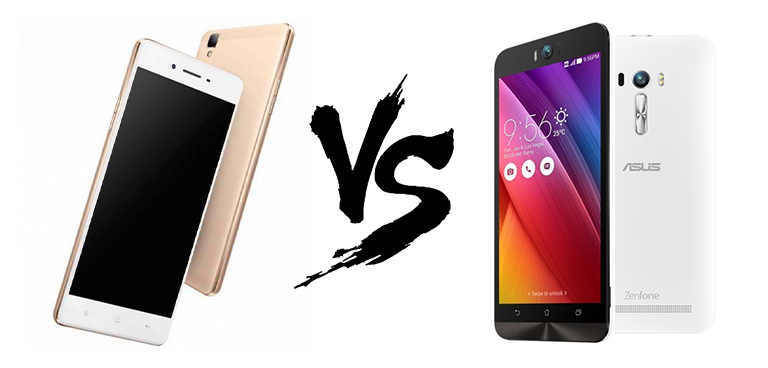With the recent announcement of selfie-centric phones from OPPO, the F1 and F1 Plus, it seems that the famous ASUS Zenfone Selfie is starting to have real competition in the selfie game. Let’s have a quick comparison of the two.

| OPPO F1 | ASUS Zenfone Selfie |
|---|---|
| 5.0-inch IPS LCD (1280 x 720 pixels), 294ppi | 5.5-inch IPS LCD (1920 x 1080 pixels) |
| 1.7GHz Qualcomm Snapdragon 616 octa-core chipset | 1.7GHz Qualcomm Snapdragon 615 octa-core chipset |
| Adreno 405 | Adreno 405 |
| 3GB RAM | 3GB RAM |
| 16GB internal storage | 32GB internal storage |
| Expandable via microSD, up to 128GB (uses SIM 2 slot) | Expandable via microSD, up to 128GB |
| 13-megapixel, f/2.2 PDAF rear camera w/ LED flash | 13-megapixel, f/2.0, laser autofocus rear camera w/ dual-tone LED flash |
| 8-megapixel, f/2.0 front camera | 13-megapixel, f/2.2, autofocus w/ dual-tone LED flash |
| Dual SIM (Nano + Micro) / Dual Standby | Dual SIM / Dual Standby |
| 4G LTE | 4G LTE |
| Wi-Fi 802.11ac | Wi-Fi 802.11ac |
| Bluetooth 4.0 | Bluetooth 4.0 |
| GPS w/ A-GPS | GPS w/ A-GPS, GLONASS |
| 2500mAh Li-Ion, non-removable | 3000mAh Li-Po battery, removable |
| Android 5.1 Lollipop w/ Color OS 2.1 | Android 5.0 Lollipop w/ ZenUI |
| 143.5 x 71 x 7.3 mm | 156.5 x 77.2 x 10.8 mm |
| 134g | 170g |
Table of Contents
With a smaller display 5″ display, the OPPO F1 is thinner and lighter than the Zenfone Selfie at 7.3mm vs 10.8mm and 134g vs 170g. However, the F1 has a lower pixel count at 294ppi vs 403ppi of the 5.5″ display of Selfie. Button placements are quite different from the two since the F1 follows a more traditional approach with side buttons while the Selfie placed it on the back. Both are IPS LCD panels and should deliver well with wide viewing angles and pleasing colors. Also, both have three capacitive buttons for UI navigation.
Qualcomm provides the chipset for both. While the two basically has the same mid-range Snapdragon octa-core chipsets, the F1, being the latest, has the edge of having the newest Snapdragon 616 variant over the Snapdragon 615 of the Selfie. Although, the GPU department has not seen upgrade since it’s still the Adreno 405. There’s 3GB of RAM on both with 16GB storage for the F1 and microSD support for up to 32GB.
Since they are branded as selfie smartphones, we’re expecting better front camera experience from the two. On paper, F1 has an 8-megapixel front shooter with an f/2.0 opening and a 1/4″ sensor. With these numbers, it should perform well in bright environments, and maybe even in low-light scenarios thanks to the large aperture. On the other hand, the Selfie has a 13-megapixel front camera with autofocus and dual-tone flash. With that, the f/2.2 opening should be compensated by the flash.
OPPO opted for a non-removable Li-Ion battery for the F1 rated at 2500mAh, while ASUS has a more maintenance-friendly removable 3000mAh Li-Po battery. The 500mAh difference shouldn’t mean that the Selfie has the advantage since the F1 lights up fewer pixels on the display, but we still have to find out when we get our hands on a review unit.
The OPPO F1 is relatively new and we’re still waiting for local availability. In Vietnam, it’s priced at 6,490,000 Vietnamese Dong or roughly around Php13,665USD 233INR 19,740EUR 222CNY 1,696 while the ASUS Zenfone Selfie has been on sale for months now at an affordable Php11,995USD 204INR 17,328EUR 195CNY 1,489.
We’ve already reviewed the ASUS Zenfone Selfie and it’s quite a charmer among consumers. You may read about it here. And, the F1 Plus, the F1’s bigger and better brother, is also in the line coming around April 2016.

YugaTech.com is the largest and longest-running technology site in the Philippines. Originally established in October 2002, the site was transformed into a full-fledged technology platform in 2005.
How to transfer, withdraw money from PayPal to GCash
Prices of Starlink satellite in the Philippines
Install Google GBox to Huawei smartphones
Pag-IBIG MP2 online application
How to check PhilHealth contributions online
How to find your SIM card serial number
Globe, PLDT, Converge, Sky: Unli fiber internet plans compared
10 biggest games in the Google Play Store
LTO periodic medical exam for 10-year licenses
Netflix codes to unlock hidden TV shows, movies
Apple, Asus, Cherry Mobile, Huawei, LG, Nokia, Oppo, Samsung, Sony, Vivo, Xiaomi, Lenovo, Infinix Mobile, Pocophone, Honor, iPhone, OnePlus, Tecno, Realme, HTC, Gionee, Kata, IQ00, Redmi, Razer, CloudFone, Motorola, Panasonic, TCL, Wiko
Best Android smartphones between PHP 20,000 - 25,000
Smartphones under PHP 10,000 in the Philippines
Smartphones under PHP 12K Philippines
Best smartphones for kids under PHP 7,000
Smartphones under PHP 15,000 in the Philippines
Best Android smartphones between PHP 15,000 - 20,000
Smartphones under PHP 20,000 in the Philippines
Most affordable 5G phones in the Philippines under PHP 20K
5G smartphones in the Philippines under PHP 16K
Smartphone pricelist Philippines 2024
Smartphone pricelist Philippines 2023
Smartphone pricelist Philippines 2022
Smartphone pricelist Philippines 2021
Smartphone pricelist Philippines 2020
neh says:
oppo f1 is subpar compare to asus selfie.. in specs and price.. price comare something more in range..
Easy E says:
Hands down sa ASUS. Ano ba yan oppo.
wnb says:
This is just a specs comparison of the two phones. Perhaps a more telling review would be if you could compare the performance of their phone functionalities and how well they perform as cameras, both in usage and picture quality.
wnb says:
Of course, not to say that the author doesn’t know this. But I hope readers won’t make a decision based on specs alone. They are almost evenly speced after all.
GIO says:
OPPO PRICE TO HIGH FOR THEIR LOW SPEC AND BAD ATITUDE